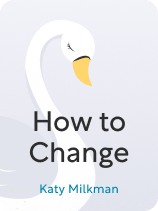

This article is an excerpt from the Shortform book guide to "How to Change" by Katy Milkman. Shortform has the world's best summaries and analyses of books you should be reading.
Like this article? Sign up for a free trial here.
What are the key points in How to Change by Katy Milkman? What does Milkman say are the keys to lasting behavioral changes?
In How to Change, Katy Milkman describes ways of using human nature to our advantage, changing habits by working with our natural tendencies as much as possible. Learning these techniques helps you to create new habits without relying solely on willpower and discipline to make the change.
Discover what Milkman has to say about habit formation by reading on.
About How to Change
In How to Change by Katy Milkman, we explore the perennial problems of personal growth—how to change our behavior. Many of us want and work for positive behavioral change, yet lasting success is difficult and often elusive. We fight against the less-advantageous aspects of our nature, from forgetfulness to impulsivity, but mainstream methods can’t always help us overcome these challenges.
Milkman, an economist and professor at The Wharton School of the University of Pennsylvania, argues that this is because we lack an effective strategy and a clear understanding of how to use human nature to our advantage. In other words, behavioral change comes not through willpower, discipline, or self-control but from a deliberate and scientific approach that uses our best knowledge about what drives human behavior.
In this article, we’ll detail Milkman’s evidence-based approach to behavioral change and discuss the “playbook” she’s prepared for the main problems we all face—from a lack of self-confidence to forgetfulness and procrastination. In commentary, we’ll take a look at adjacent perspectives on behavioral change from books such as Atomic Habits, Nudge, Awaken the Giant Within, and Hooked.
Why Change Requires Targeted Solutions
Milkman recommends that you approach behavior change as an engineer approaches an engineering problem: First, understand the problem. Then, devise a solution that’s tailored to the specifics of the problem. When it comes to behavior change, this means understanding the forces within and without us that influence how we behave—and then adapting solutions that work to overcome them or turn them in our favor.
Say you want to start meditating each evening. To use Milkman’s approach, you’d first evaluate the situation: What problems have you faced in trying to do this? What’s working for you, and what’s working against you? For instance, maybe you get easily distracted and seek out easier, more pleasurable activities.
Then, you’d create a strategy that leverages those forces to your advantage—such as by planning to reward yourself with a favorite guilty pleasure but only after you’ve completed your meditation.
Change and Good Timing
Understanding how to change a behavior is only one piece of the puzzle—next, we need to understand when to do so. According to Milkman, the best time to change a behavior is when you have the chance to start anew. Think of these moments as “new beginnings.” Put simply, a new beginning comes when a new date, event, or physical change offers you the chance to begin again.
New beginnings work because we think of our lives as narratives or stories rather than as continuous experiences. So when a chapter or phase of your life ends, that feeling that you’re turning a new page helps you to make a change. Psychologically, you feel distanced from past failures and unhelpful labels you might be carrying (“I’m a loser; I can’t change”) when a substantial change happens in your life.
Change Requires Self-Confidence
Having an effective strategy is one thing; knowing how to time it is another—but neither matters if you lack the self-confidence to successfully implement it. According to Milkman, believing in your ability to succeed can make or break any effort to change your behavior. This is because our expectations (or beliefs) about what will happen influence what transpires in at least four ways:
- Emotionally, your expectations can either drum up your energy or suppress it. When you feel good about your chances of making a change, that emotional energy will help you to succeed.
- Attentionally, positive expectations can help you to interpret a difficult activity—such as grinding out hours of deep work—as something energizing and enjoyable.
- Motivationally, the way you interpret things can improve your ability to follow through—for instance, focusing on the cognitive benefits of deep work can improve your energy levels.
- Physiologically, positive expectations can change how your body responds to an activity and thereby yield better results.
Overcome Common Barriers to Change
Having discussed the nature of Milkman’s core strategy for behavioral change, we’ll next dive into her playbook for overcoming the most common hurdles people face when attempting change.
In the following sections, we’ll discuss the perennial problems posed by human nature, including our tendency to seek instant gratification, our laziness and procrastination, and the all-too-common experience of forgetting about our good intentions. Alongside these discussions, we’ll present Milkman’s advice for overcoming these challenges within yourself—as well as how you can help others to do the same.
(Shortform note: In reading through the following sections, note that Milkman frames these aspects of human nature as problems to be solved. Since how we frame things influences our choices and our emotions, consider an alternative framing from Stoicism—view these things as opportunities to be learned from. This can reduce frustration as you’ll see yourself not as riddled with flaws to fix but as ripe with opportunities to grow.)
Barrier #1: Instinctively Seeking Pleasure
First, let’s look at the one obstacle to change that underlies most others: The human tendency to seek instant gratification. As Milkman puts it, we instinctively want immediately gratifying experiences and thus favor behaviors that produce present-moment pleasure over those that would benefit us in the long run. We impulsively overeat, overconsume media, have just one more drink, or scroll just another minute. This tendency is a scientifically established feature of human nature—scientists call it “present bias.”
Barrier #2: Avoiding the Effort
Keeping in mind the human tendency to seek instant gratification, Milkman turns next to procrastination—a common way that we avoid hard things in favor of an easier present.
Milkman suggests overcoming procrastination by placing constraints on yourself that will penalize you if you continue to avoid important tasks or behavior change efforts. In other words, you can commit to follow through on your good intentions and devise a personal cost that you’ll pay if you fail. You can make “hard” or “soft” commitments:
- Hard commitments use serious, often material penalties, such as losing money. Milkman recommends using services that hold you accountable to these costs.
- Soft commitments involve less serious penalties, such as the psychological cost of breaking a promise to yourself or an accountability partner.
As a rule of thumb, Milkman says that the harder a commitment is, the more effectively it’ll prevent procrastination. This is because we find it easier to pay psychological costs, such as guilt or shame, than material costs, like $1,000 cash.
Barrier #3: Lacking the Energy
Sibling to procrastination is the simple fact that we often lack the energy or motivation to make positive behavioral changes. As Milkman explains, this is human nature: We’re wired to find the easiest way forward, and, in the modern world, this often means that we avoid doing effortful things that are good for us.
Much like her earlier advice to use your pleasure-seeking nature to your advantage, Milkman suggests leveraging laziness. Specifically, she explains that if we can make good behaviors our default choices—our paths of least resistance—then our instinct to coast will help us improve.
Barrier #4: Forgetting Your Intentions
In a related vein to procrastination and laziness, we face the obstacle of forgetfulness. As Milkman puts it, our working memory (the amount of information we can hold in our heads at one time) is limited, and in the hustle and bustle of our busy lives, many of us blank out on our intentions to develop better behaviors. She suggests two tactics to solve this problem:
- Set timely reminders that cue action. Reminders work best when they come right before you’re supposed to take action. When you prompt yourself to, say, prep lunch for the week right before you meant to do so, you’re far more likely to follow through.
- Link your cues to specific action steps—for instance, you could define a sequence of behaviors that compose the morning routine you want to build. Then, link a cue (such as your alarm clock ringing) to the first step and carry out your plan from there.
Barrier #5: Following the Group
Pivoting to behavioral change at scale, Milkman next discusses how social norms have a strong influence on our behaviors. In short, we tend to go along with what our peer groups do, for at least one of two reasons:
- We want to fit in. Historically, being ostracized from the group could’ve meant death, so we’re wired to place a high value on group belonging.
- We assume the group knows something we don’t, and it’s probably beneficial to go along with them. For instance, you’d want to go along with your peers if there seems to be an office evacuation in progress, even if you don’t know why.
Exercise: Plan and Initiate a Behavior Change
Put Milkman’s core strategy into action by identifying a change you’d like to make and tailoring a solution.
- First, identify the behavior you’d like to change. For instance, you might want to change a habit of eating too quickly or a pattern of watching YouTube in bed before sleeping.
- Next, take stock of any challenges you might face in changing this behavior. For the above examples, these challenges could be struggling with instant gratification or forgetting your good intentions after a long and stressful day.
- Now, consider whether you’ll have any new beginnings to work with. Is there a change coming up in your life circumstances that will afford you a fresh start? (Consider whether any big events, possible moves, or symbolic dates are near.)
- Last, from Milkman’s playbook, pick a tactic you could use to change this behavior. Continuing the example of watching YouTube before bedtime, you might set a reminder to place your phone across the room before lying down. Put this tactic into action, and you’re on your way to positive change!

———End of Preview———
Like what you just read? Read the rest of the world's best book summary and analysis of Katy Milkman's "How to Change" at Shortform.
Here's what you'll find in our full How to Change summary:
- An evidence-based approach to creating lasting change
- How to overcome common human failings, such as procrastination
- When the best time to enact changes in your life is






